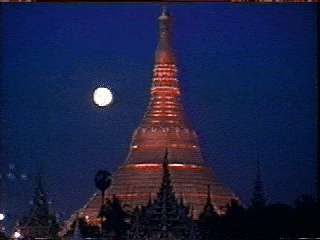Some Hints on Burma
Burma is a country in South East Asia.
Location is between India, China and Thailand. There are approx. 5 millions of Chinese races and 5 million of Indian races in this country together with 35 million of Myanmar nationals.
The following are some hints for Burma
1.Aung San Suu Kyi
1945–, Opposition Leader, Noble Peace literate.
Burmese political leader. Daughter of Burmese nationalist Aung San, who is
regarded as the founder of modern Myanmar, she lived outside Myanmar after 1960.
Returning in 1988 to care for her mother, she joined the opposition to U NE WIN and became leader of the National
League for Democracy. She was placed (1989–) under house arrest for her outspoken criticism of the government. In 1990 her party won the parliamentary elections, but the military refused to surrender power. She was awarded the Nobel Peace Prize in 1991 for her nonviolent struggle for democracy.
|
Aung San Suu Kyi
 |
2.U Thant (thänt), 1909–74
Burmese diplomat, secretary general (1962–72) of the UNITED NATIONS. He became acting secretary general in 1961, on the death of Dag HAMMARSKJÖLD. Influential in settling disputes in West New Guinea (1962) and the Congo (now ZAÏRE; 1963), he played a mediating role in the CUBAN MISSILE CRISIS (1962), but was less successful in efforts to resolve the VIETNAM WAR. He retired in 1972.
3.Bhandanta Vicitsara
Recited 16,000 pages of Buddhist canonical texts in Yangon (formerly known as Rangoon), Myanmar (fromerly Burma) in May 1974.
From "GUINNESS BOOK OF WORLD RECORDS for Memory"
4.Oldest Pagoda
The 326 ft. tall Shwedagon Pagoda, Yangon (formerly Rangoon), Myanmar (formerly Burma) is built on the site of a 27 ft.-tall pagoda of 585 B.C
From "GUINNESS BOOK OF WORLD RECORDS for Pagoda"
|
 |
5.BURMA (bûr¹me) or Myanmar
Officially Union of Myanmar, republic (1986 est. pop. 39,411,000), 261,789 sq mi (678,033 sq km), SE Asia, bordered by India, Bangladesh, and the Bay of Bengal (W), China (N and NE), Laos and Thailand (E), and the Andaman Sea (S). Principal cities include RANGOON, the capital, and MANDALAY.
History
The Burmans established a kingdom in Upper Burma in the 9th cent. Under King Anawrahta, who introduced Hinayana Buddhism, they gained (11th cent.) supremacy over the rival Mon kingdom and the Irrawaddy delta. The Burmese capital, Pagan, fell (1287) to the Mongols, and the area was then divided among local rulers. The Burmese Toungoo dynasty united the area in the 16th cent. A resurgence (18th cent.) of Mon rule was checked (1758) by Alaungapaya, who extended Burmese influence. During three Anglo-Burmese Wars (1824–26, 1852, 1885) Burma was annexed piecemeal to British India and did not receive limited self-government until 1937. Occupied by Japan in World War II, Burma achieved complete independence in 1948, with U NU as prime minister. Economic chaos and opposition by insurgent minorities plagued the new government, and in 1958 leadership passed to Gen. NE WIN who restored order. U Nu was returned to power in 1960, but conditions continued to deteriorate, and in 1962 Ne Win staged a successful military coup. A new constitution, making Burma a one-party socialist republic, was adopted in 1974. Under Ne Win, Burma was reduced from one of the most prosperous to one of the poorest countries in SE Asia. Ne Win resigned as president in 1981 and party leader in 1988. In Sept. 1988 the military brutally crushed prodemocracy demonstrations but later promised national elections. The antigovernment National League for Democracy, whose leader, Aung San Suu Kyi, was under house arrest, won the 1990 parliamentary elections, but the military refused to surrender power and continued to suppress opposition.
6.Pagan
{puh-gahn'}
Pagan, a village on the Irrawaddy River in central Burma, was once a great walled city of old Burma. Founded in AD 849, it flourished until overrun (1287) by the Mongols. King Anawratha (r. 1044-77) made Pagan his capital, summoning foreign artisans from eastern India and from the MON kingdom of southern Burma to build and decorate Buddhist shrines and royal palaces there. Many still stand, making Pagan the largest surviving complex of the medieval brick and stucco buildings that once flourished throughout Southeast Asia. The main architectural types are tall, bell-domed stupas; square shrines with terraced roofs and curvilinear towers--the great Ananda Temple (1091) is still in use; smaller enclosed shrines for spirits (Nats); and halls and libraries with sloping or terraced roofs often adorned with flamboyant ornament. Wall paintings and terra-cotta reliefs, some glazed, representing Buddhist subjects in a schematic style, are found in a number of Pagan's monuments.
Phillip Rawson
Bibliography: Aung-Thwin, Michael, Pagan (1985)
7. Highest Mountain in South East Asia
Hkakabo
Razi is located at upper Burma (Kachin
State) with 19294 feet. In 15-Sep-1996, a Jananese Jepang
Takashi Ozaki and local Burmese Johnson conquered
http://www.americasroof.com/world/asia-highest.shtml
Compiled by Zaw Aung on 1st Nov 1996.


 Kachin State
Kachin State